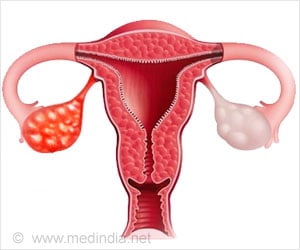The structure of a key part of the machinery that allows cells to divide has now been identified by a team of researchers

"This fills in a major missing piece, because for the first time we can understand how microtubule filaments can be linked together and slide past each other," he said.
The work will be published in the online journal eLife and is available at (elife website DOI)When a cell divides into two new cells, a structure called the mitotic spindle forms. Microtubules of protein fan out from each end of the cell, capture chromosomes and draw them apart into what will become the two new cells. Precise coordination of this process is crucial for cells to divide properly, and for avoiding birth and developmental defects.
Cancer cells divide continuously, so this process repeats itself much more often in cancer cells than in normal cells.
The kinesins are a large family of motor proteins that move items around inside cells, said Jonathan Scholey, professor of molecular and cellular biology at UC Davis and an author on the paper. Generally, they have two motor units at one end that can "walk" along a microtubule, dragging cargo attached to the other end of the protein.
Originally identified as a protein essential for mitosis in fungi, kinesin-5 was first purified about 20 years ago by Scholey's lab who found that it is unusual because it has motor units at both ends, allowing it to link two microtubules and walk them past each other.
Advertisement
Using electron microscopy and X-ray crystallography, Al-Bassam, Scholey, Project Scientist Stanley Nithianantham and research specialist Jessica Scholey determined the atomic structure of the central rod of kinesin-5. They found that it is made up of four long helices of protein bundled together, two running in each direction.
Advertisement
The structure also revealed "pockets" unique to kinesin-5 that could be exploited as targets for new anti-cancer drugs. Kinesin-5 has been identified as a target for drugs to treat cancers that involve uncontrolled cell division, such as colorectal cancer, Al-Bassam said. One such drug recently advanced as far as phase III clinical trials but ultimately was not approved for general use because of its effect on other motor proteins. Drugs that could target kinesin-5 more precisely by binding the newly identified pockets would be a big advance, he said.
The structure also explains how forces can be transmitted through the central rod between the end motor units, Al-Bassam said.
"Previously we had only a cartoon-level model of how this so-called 'sliding filament' mechanism works, but the new work takes it to the next level and opens up the possibility of learning how it really works at an atomic scale, which is exciting," Scholey said.
Source-Eurekalert













